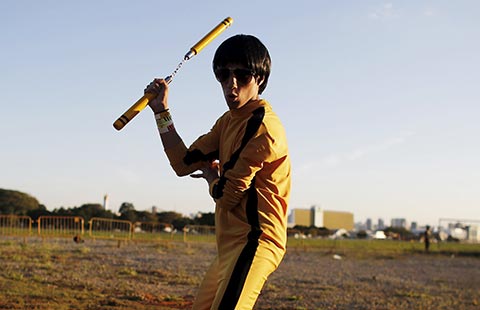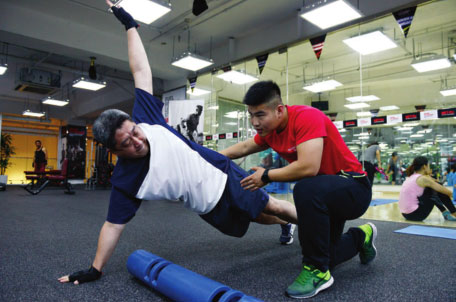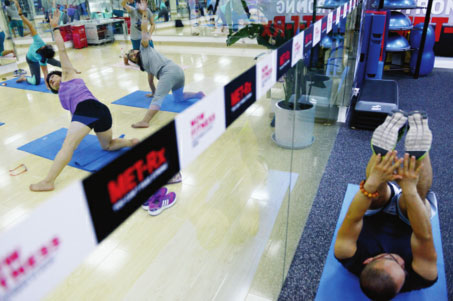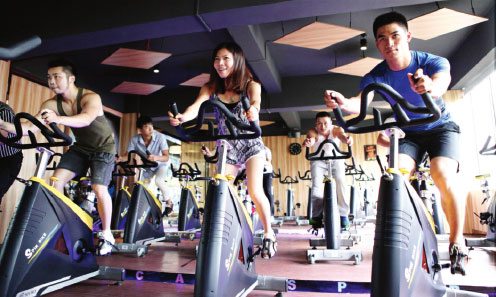Newcomers plan to muscle in on China's gyms
Updated: 2015-07-22 07:54
By Sun Xiaochen(China Daily)
|
|||||||||
The nation's fitness industry is growing rapidly, boosted in part by a new wave of workout warriors, who are providing 24-hour availability, personalized training plans and a chic clientele to build their exercise empires. Sun Xiaochen reports.
Every night at about 10 pm, just as the surrounding stores and restaurants are closing for the day, rush hour is beginning at NowFitness, Beijing's first 24-hour gym and workout center.
Entering the well-equipped, two-story facility located in a commercial complex in the capital's eastern downtown, it's hard not to react to the adrenaline rush generated by the scenes on display. The sound of dumbbells smashing together, treadmills buzzing at high speeds and exercisers groaning and creaking competes with a background of electrifying pop music to energize customers and encourage them to work out, no matter what the hour.
Lin Peng, a white-collar employee who lives locally, is one of NowFitness' 500 members and he exercises three times a week at the gym, a 10-minute walk from his apartment.
"It's really cool to have a gym running day and night on your doorstep so you can make full use of your spare time, even late at night. Not to mention the cutting-edge facilities and motivational atmosphere," the 32-year-old said.
Lin is one of a new wave of middle-class Chinese who have enthusiastically embraced exercise as a way of keeping fit. The 2008 Beijing Olympics signaled a shift in China's sporting focus from simply winning medals at major events to extending the benefits of a high sporting profile to public health and well-being.
The appetite for a healthier life-style has resulted in a surge in memberships at fitness clubs, a trend compounded by urban consumption leaning further toward leisure and recreational activities in recent years.
As a result, working as a fitness trainer has become a promising and appealing career choice for college graduates and retired athletes.
Challenging and rewarding
When he arrived in Beijing in September, Wang Gang, from the Inner Mongolia autonomous region, had no idea how he would make a living. He was 18 and had just retired from semi-pro weightlifting.
As an up-and-coming athlete, Wang had received a very limited education. He had little hope of a lucrative post-athletics career until he signed up for a two-month course to earn the National Fitness Trainer Certificate issued by the General Administration of Sport of China, the country's top governing body for sports. "To be a professional fitness instructor seems a natural fit for me because I will be able to make a living by using my long experience and knowledge of physical training and strength exercises to benefit other people," he said.
Wang obtained the certificate and was hired by NowFitness in December. He has since become one of four trainers employed to offer personalized one-on-one courses to members.
On a typical day, Wang works with at least four clients individually for 60 minutes each, and spends the rest of his time patrolling the gym and offering guidance to regular visitors.
His leisure time is mainly devoted to designing tailor-made training programs for his clients and maintaining his own workout routines.
Earning a cut of 25 percent of the fee for each one-on-one session, and with a low basic wage, Wang can earn at least 12,000 yuan ($1,933) a month in his rookie year, almost three times the monthly per capita disposable income in Beijing.
"I'm happy with my income, but what satisfies me more is the sense of accomplishment after helping my clients stay in good shape and seeing my expertise deliver," he said.
According to analysis undertaken by the Sports Industry Commission at the China Sports Science Society, professional fitness trainers in urban China have joined the upper-middle income group, with estimated average monthly incomes ranging from 8,000 to 15,000 yuan.
Still, challenges such as heavy sales pressure and picky customer requirements present tough learning curves for up-and-coming trainers such as Wang, who are desperate to succeed.
Hidden agenda
Irrespective of their size, all fitness clubs in China are heavily reliant on sales of lucrative private training courses. The market is highly competitive and low membership fees mean few clubs can make ends meet.
"Gyms always attract customers by offering affordable, discounted membership fees, and then try to make a profit by selling private classes, with prices varying from 300 yuan to 800 yuan an hour," said Han Bing, manager of a branch of Tera Wellness Club in northeastern Beijing.
"Sales assignments are allocated to the trainers, who are forced to practice networking and sales techniques rather than the things they are supposed to do at gyms," Han said.
"Firing trainers because they rank low on the sales list, regardless of their actual training ability, is a sad but normal practice adopted by many clubs nowadays," he said.
Meanwhile, unusual requests from customers, including occasionally over-intimate physical contact, are another headache, and not only for female instructors, according to Han.
"Some female clients asked me to give them a massage while working out. Sometimes it went to a little too far and almost developed into horseplay, which would be unforgivable for a male trainer."
"Staying emotionally close to your clients as a good training companion and sounding board helps to build loyalty, and that benefits your sales, but you must remember to never cross the line."
The recent boom in the fitness industry has resulted in a new problem rearing its head - a massive shortage of qualified trainers.
Yang Bin, the NowFitness owner who started his career as an entry-level trainer, said the key asset for a successful gym, no matter how heavily it has invested in equipment, is always the training team.
"Newcomers enter the industry every day, but clubs are always short of well-trained employees," said Yang, who opened NowFitness in January after working as a personal trainer for more than 10 years. "The use of inexperienced trainers has taken a toll on several hard-won reputations in the business."
A report into China's gym, health and fitness club industry, released in June by the market research organization IBISWorld, estimated that more than 16 million people will visit China's fitness clubs this year.
The report found that approximately 202,025 people are employed as trainers in the nation's 2,322 fitness franchises and private studios, but by the end of 2014 only 15,909 of them had passed the theory and practical tests necessary to be awarded the national fitness trainer certificate issued by GASC's Vocational Skills Assessment Center.
Liu Qingzao, deputy secretary-general of the China Sports Science Society's Sports Industry Commission, said that although several organizations, such as the Asia Academy for Sports & Fitness Professionals in Hong Kong, offer training courses for a large number of trainers, the industry is plagued by unprofessional practices.
"The introduction of a mandatory entry requirement for employees in the fitness and health industry is urgently needed, because the country has set goals to boost the sports industry," Liu said.
Since 2010, GASC's Mass-Fitness Department and Beijing Sport University have jointly organized the annual National Fitness Trainers Convention, which provides a national platform for exchanges related to personalized fitness training, sports science, sports medicine and nutrition, and weight management.
"We expect to help improve the overall standards of fitness instructors, while raising the bar for fitness services in China," Liu Guoyong, director of the department, said.
The way forward
In October, the State Council issued measures to boost the sports industry. The sector has been tasked with generating gross value of more than 5 trillion yuan by 2025, when it's expected to account for 1 percent of GDP, compared with 0.6 percent in 2012.
The measures also stipulate that the number of people participating in exercise regularly, at least three times a week, is expected to reach 500 million by 2025.
According to the IBISWorld report, the health and fitness club sector - which has recorded average annual growth of 17.5 percent for the last five years - will generate $5.14 billion this year.
Adam Zhang, founder of the sports consultancy Key-solution, predicted that the official backing would inspire another wave of investment into the fledgling industry, just as it did in the run-up to the 2008 Beijing Olympics, and established independent operators would gain the most.
"Quality has been more a core value of successful fitness clubs for many years, far more than cheaper membership fees or more outlets. Small-scale gyms that guarantee customized, feature services are more likely to benefit than average chain clubs nowadays," he said.
The increasing popularity of Energy Fitness, a private fitness studio that offers services tailored for a specific market and is run by model-turned-trainer Lu Chang, is the sort of place Zhang was talking about.
Located in a hotel in Beijing's downtown, the 150-sq-m studio has become a popular bodybuilding workshop for professional models, thanks to Lu's sense of fashion, personalized training programs and dietary suggestions.
"We don't need to attract as many members as the big clubs. We just try to appeal to a certain group of bodybuilders and build our brand with high-quality, one-on-one courses," said Lu, who started his modeling career in 2003.
Lu began taking fitness trainer courses at the AASFP when he moved to Hong Kong for work in 2006, and has obtained the academy's advanced personal fitness trainer certificate.
He opened the studio in Beijing in June last year, having hired three other good-looking male trainers. More than 100 workout addicts, mostly female, have signed up for the gym's long-term fitness services, despite the charge of 550 yuan per 90-minute personal session.
Li Yujie, an architectural designer who was exercising at Energy Fitness, said working out at the gym is a pleasant experience, both visually and emotionally.
"Taking exercise with a group of handsome, friendly men definitely gives you a lot of positive energy, not to mention their professional knowledge and the way they're so encouraging when you face a bottleneck in training," said Li, who has shed 14 kg in the past year.
Lu is also active organizing commercial photo shoots with his fellow trainers to maintain their high level of exposure.
"I just want to show everybody a healthy and vibrant image of fitness trainers, because they deserve a greater share of the spotlight in the fitness and health industry," he said.
Contact the writer at sunxiaochen@chinadaily.com.cn

|
Wang Gang (right) provides one-on-one training for a client. Wei Xiaohao / China Daily |
|
People work out at 9 pm at NowFitness, a 24-hour club in Beijing. Wei Xiaohao / China Daily |
|
Hitting the gym is considered fashionable in Dongxiang, Jiangxi province. He Jianghua / for China Daily |
|
As more well-equipped fitness clubs open in China to meet the rising demand for healthier lifestyles, the fitness industry faces a shortage of qualified trainers. He Jianghua / for China Daily |
(China Daily 07/22/2015 page6)

 Rare imperial porcelain revealed for first time in Capital Museum
Rare imperial porcelain revealed for first time in Capital Museum
 Cosplay enthusiasts pose during 'Anime Friends' in Brazil
Cosplay enthusiasts pose during 'Anime Friends' in Brazil
 Top 10 services changed by online-to-offline
Top 10 services changed by online-to-offline
 People evacuated after downpour in SW China
People evacuated after downpour in SW China
 Identifying counterfeit money
Identifying counterfeit money
 A New Era in US-Cuba Relations Begins
A New Era in US-Cuba Relations Begins
 Eat the 'flesh' of 'Monk Xuanzang' at this shop
Eat the 'flesh' of 'Monk Xuanzang' at this shop
 The dying of craft of repairing pans
The dying of craft of repairing pans
Most Viewed
Editor's Picks

|

|

|

|

|

|
Today's Top News
Ling Jihua's arrest a vital lesson for officials
Cuba, US ties called first step
Life details of Tennessee shooter emerge, but motive elusive
China can now shop at JD.com's US Mall
UN Security Council endorses Iran nuclear deal
US, Cuba set to reboot relations after split
Mayor to turn Zhanjiang into green economic powerhouse
Private firms' access to arms sector widens
US Weekly

|

|











